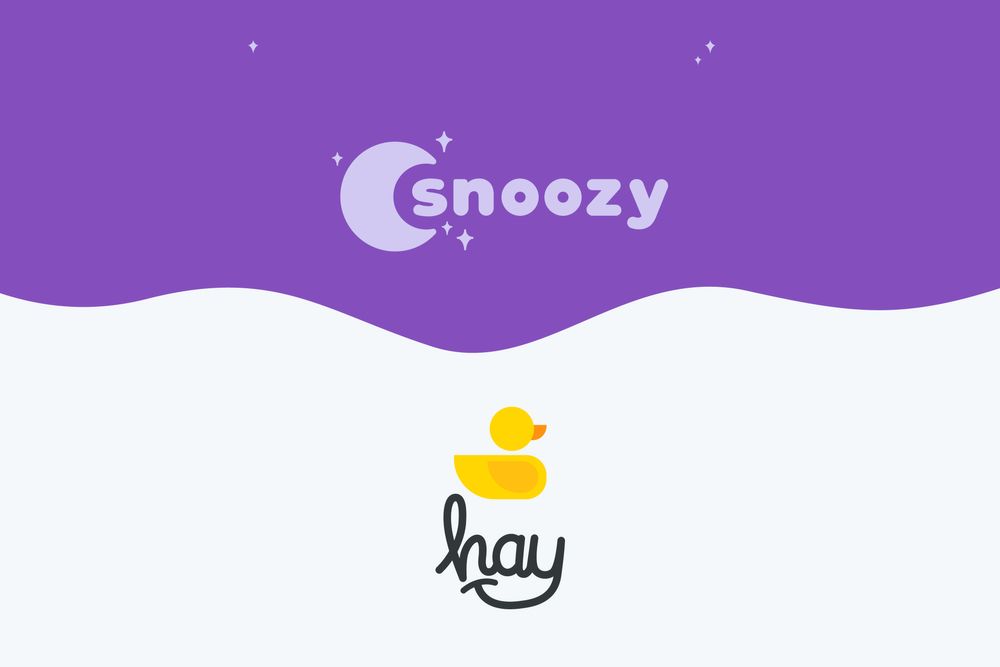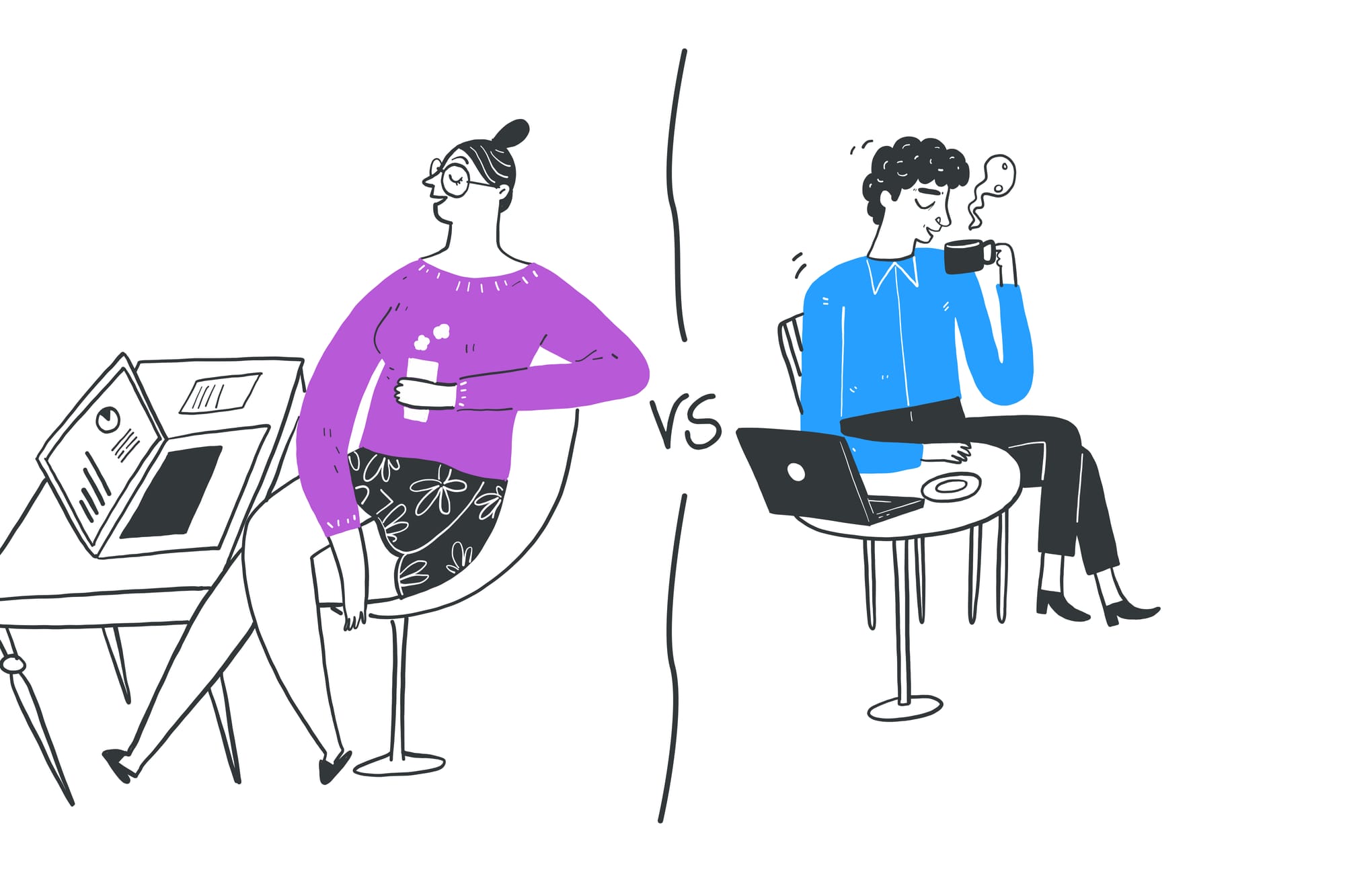What does a phone do when it wants to sleep? It downloads a nap 😂
Now that I got your attention with a funny sleep joke that ties this case study together with 1) an app 2) a nap 3) and mobile technology, let me tell you why we launched two different products on Product Hunt within 15 days of each other.
So the story goes…
Several months ago, our Chief Designer, Mareta, wanted to try out some new illustrations in an Investment Time project. Her creativity, however, was hindered by her inability to get a good night’s rest 💤 She also heard from a few software engineers that they wanted to experiment with the latest technology, specifically SwiftUI.
Around this time, we began reevaluating our company policies to prioritize the health and wellbeing of our developers. Amidst the challenges posed by the pandemic, recession, and the conflict right in our backyard, our focus shifted towards ensuring the happiness (and restfulness) of our dev teams. So, combining all these events, Mareta decided to build a sleep app.
The pitch to codequest’s partners went like this: how about we create an app where users could design their own soundscapes by mixing and matching ambient atmospheres and soothing sound effects - right before bedtime? How about we call it Snoozy?
With the pitch to our own internal dragons considered a success, Mareta didn’t sleep much on the idea (forgive the sleep pun 😂). She called on those resourceful engineers once again and told them her idea, which they thought was great. Of course, Mareta took care of the design along with her second-in-command, Wero.
Team Sleep quickly got to work, brainstorming the app’s scope, wireframing, and main features. Time went by, dots connected, lines crossed, and code crunched (and reviewed) until the final product was ready.
But what do we do now?
Since Snoozy was only a passion project with no intentions of it becoming a game-changer in digital health, our product manager, Krzysztof, suggested launching it on Product Hunt as a way to prepare for the launch of hay for Slack, an own venture we really wanted to promote. It sounded like a great idea!
hay for Slack is a solution that I’ve been working on for a few months now. The ‘for Slack’ part means it’s our MVP of our MVP, a plug-in that allows engineering managers to gauge happiness and satisfaction via Slack without having to change contexts. It’s our first step before developing our engineer-focused platform that helps engineering managers run insightful and forward-focused 1-on-1 meetings.
The full hay platform merges engineering analytics with people management and feedback tools. It will also empower engineers by helping them closely examine their wellbeing, work output, career growth, and team feedback.
I’m so passionate about this subject. It keeps me up at night, in a good way, of course, as I’ve been reading as much as I can about wellness and performance management in software development 🐱👓
Snoozy as an educational springboard for hay for Slack
Our Head of Marketing, Marius, had never headed a product launch on Product Hunt before, so there was much to learn and do with Snoozy i.e., logos, taglines, gallery images, first comments, outreach.
Because this was more like a flash campaign, we mobilized our team as fast as we could and put on our many hats to reach out to our network. Our main goal was to ask for upvotes with the hopes that it would convert to downloads. Product Hunt is a great place to launch because it helps makers validate their ideas and get feedback.
Here’s what we did for our pre-launch and day-of-launch:
From Mareta's LinkedIn:
- Posted in 11 groups, from art and UX communities to tech groups.
- Received 1,554 organic impressions.
- Direct message to all of Mareta’s 594 contacts, asking for an upvote.
Mobilized our software studio to upvote
- 45+ codequesters were asked to upvote (coordinated by Krzysztof Malinowski 👍🏽).
Launched a cold email campaign
- 345 out of 613 people from a lead list received a pre-launch email.
- 0 people received day-of-launch email.
- ⚠️ OUR ACCOUNT WAS SUSPENDED DUE TO SPAMMING ⚠️
Outreach
- Emailed 21 Bloggers/Influencers/Podcasters. We asked for them to check out Snoozy, not for an upvote.
- Shared Snoozy on 11 boards/walls in 7 health & wellness community groups.
- Messaged 100 people in a ‘Sleep Disorder’ forum in a health community.
- Reached out to 2 sleep-related blogs and websites.
- Emailed 7 sleep and corporate health vendors (requesting a partnership).
Here are the results of Snoozy’s launch March 9th on Product Hunt:
- 📈 Position#11
- 🔺Upvotes 248
- 💬 Comments 57
As you could see, our total downloads were pretty low in the week preceding the launch. But after Snoozy's Product Hunt release, we managed to gain a significant increase in downloads.
As of March 29th, we have a total of 440 downloads.
What did we learn on Snoozy’s launch day (March 9th) that we transferred over to hay for Slack's launch (March 24th)?
Leaderboard and vanity metrics
Of course, everybody wants to be #1, but gunning for the top spot distracted us a bit and created unnecessary worry over getting a good result. Also, we didn’t have as much fun with the launch as we should have. That’s because we were trying to establish a best practices guide for hay for Slack’s launch.
We also fixated on what other products did and how they launched, especially companies like Miro, who probably have bigger budgets and bigger teams working on their launches and updates.
For hay for Slack’s launch, we were less glued to our launch page and more focused on our tasks. Admittedly, it was hard - every upvote is like a shot of dopamine 💉 to our brain and serves as a good pat on the back.
At the end of the day, we know we got a great product, and we know we could compete with our competitors. We just need to continue telling the world about hay for Slack and why it could be a better solution.
Let’s get a discussion going!
On Product Hunt there’s an option to post a question in the community. For Snoozy, we didn’t do that, but for hay for Slack, we did. Have a look:
Posting a question in the community created some buzz surrounding our core subject and resulted in greater engagement. It’s also a good strategy to use as my face was attached to the product and, in some ways, that could allow me to model myself as an advocate for developer wellbeing.
I did see some other Makers follow me and upvote hay for Slack on launch day. Overall, we learned how other Makers view developer wellbeing - this always helps us further understand our market so that we could make improvements to hay for Slack.
For Snoozy, we didn’t have a video
But for hay for Slack, I got in front of the camera and showed how hay for Slack’s pulse survey works, and how it could help engineering managers start conversations based on mood trends amongst their developers.
Having a video on Product Hunt is a great way to grab the attention of potential users. It boosts time spent on the landing page, overall visibility, and increases the chances for a conversion. Done right, it also helps get your message across clearly and in a fun way.
Re: emailing! Don’t spam people asking for an upvote and then get blocked 😂
We wanted to get our product seen (and upvoted!) by as many people as possible, so we pinged hundreds of leads from past projects. Unfortunately, we disregarded the email limit. This resulted in our email account getting suspended temporarily.
For hay for Slack, we segmented out our emails pre-launch to avoid such a mishap.
Scaled leveraging of my LinkedIn network
For Snoozy, we reached out to about 600 people in Mareta’s LI network asking for an upvote. Though we didn’t experience any backlash to randomly DM’ing people, it’s always important to be extra nice and respectful when asking for such support, especially when you may not know some of the people you’re asking to upvote.
For hay for Slack’s release, I reached out to 1300 colleagues on LinkedIn politely asking for an upvote. Many were happy and showed support, either verbally or with an upvote. Of course, a few wrote back saying we were spamming them, but how else do you do such outreach without being a little intrusive? As mentioned above, if somebody gets angry, be nice, apologize, and say it won’t happen again. Put their name on a no-contact list.
Launch day, does it really matter when?
For Snoozy, we launched on a Thursday and got 248 upvotes. Hunters and experienced Makers say that Monday to Thursday are competitive days to launch. Fridays to Sundays are less competitive and easier to get a Product of the Day. They say startups never sleep, but are there people actually around to vote on Saturday afternoon? 🙃
For hay for Slack, we launched on a Friday because 1) we just wanted to get our product out and 2) we believed that it would be easier to get more eyes and more comments.
Onwards and upwards
As mentioned, hay for Slack is our MVP of our MVP. It’s the first phase before we start developing our engineer-focused platform that helps engineering managers run effective 1-to-1 meetings with their software developers.
We really wanted to get hay for Slack’s launch right. We did it on the back of Snoozy, and we were willing to make mistakes with that app to make sure we didn’t make the same mistakes with hay for Slack.
I bootstrapped hay for Slack myself and wanted a good launch on Product Hunt. A good launch, as you know, could really help us reach our target and shift our marketing into second gear. It could definitely bring our company and product some much-needed attention.
Here is the result of our marketing efforts for hay for Slack’s launch on March 24th.
From Tomek’s LinkedIn
- Posted on hay’s wall: 362 impressions.
- Messaged ~1300 people in Tomek’s network asking for an upvote.
- Posted on Tomek’s wall: 1,138 impressions.
- Posted in 14 groups: 470 impressions.
From Karwer’s LinkedIn (codequest’s CTO)
- Messaged ~500 people in Karwer’s network asking for an upvote.
- Posted in 11 Groups: 244 impressions.
- Posted in 5 Facebook groups.
Mobilized our software studio to upvote
- 45+ codequesters were asked to upvote (coordinated by Krzysztof Malinowski 👍🏽).
Launched a cold email campaign
- 888 out of 1257 people from a list received an email asking for an upvote.
- 48.1% opened an email.
- No way to track on Product Hunt where page visits and upvotes came from 😥
Outreach
- Emailed 11 Bloggers/Influencers/podcasters (pre-launch visibility, not asking for upvote).
- Shared hay for Slack on 9 walls in 4 community groups.
- Shared hay for Slack in 7 Slack channels.
- Submitted hay for Slack to 4 platforms similar to Product Hunt. Two of them requested money to post the product after submitting
- Ranked 7th out of 55 products 🎉
- 4 users are trying out the product.
- 4 demo calls were requested after the launch.
- Our goal was for 20 users to sign up (with credit card) 😥
Discussion
We had our Retro a few days after hay for Slack’s launch and discussed what worked and what didn’t at length. We analyzed all the data and tried to compare both products’ outcomes.
Let’s admit it, we didn’t reach our goal of getting 20 people to sign up for hay for Slack. Why? It’s complicated, but here’s what we think.
Snoozy is B2C and is free. Anybody could enter the site and be directed to the Apple Store to download our sleep app and start using it right away. There are pretty much no barriers to accessing it. You can download it right now if you want.
hay for Slack, on the other hand, is B2B and is a product marketed to a very narrow niche - engineering managers and technical team leads. Even though we offered a free trial of the product, those interested would have to be admins of their Slack workspace to get it installed. In some cases, they'd need approval from a higher-up. That immediately reduces the user base from pretty much everyone to a very specific few.
I suppose these are some of the problems of developing niche products, where the smaller market, the more difficult to grow. In our case, we know there is interest in such a product (we did tons of research), but our potential customers just don’t know that they need it (yet!).
Interestingly, our research showed that there are many competitors to Snoozy that offered their services via paid subscriptions. But Snoozy was for free, so it could’ve attracted those not wanting to pay. We think this is why we got a significant uptick in downloads immediately after Snoozy’s launch.
The opposite was true for hay for Slack - some of our competitors offered up to 15 free surveys, but our subscription was paid with an unlimited amount of surveys to send out in a workspace.
Conclusion
I’d like to think that failure isn’t always a bad thing. After examining both products and seeing how they did, valuable lessons can be learned that can inform future product development and marketing strategies.
It’s always hard to palate such a truth, but product failures are a common occurrence in business, and even the most successful companies experience them.
It is crucial for companies to be agile and adaptable in the face of failure, and to view it as an opportunity for growth and learning.
We will grow, get it right, and continue learning! 🦾





